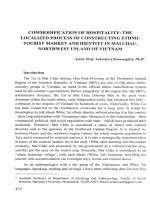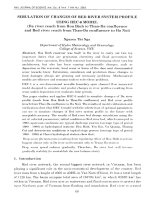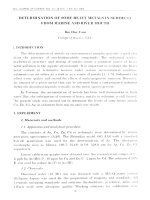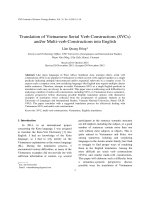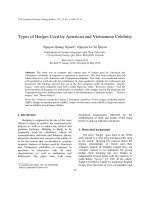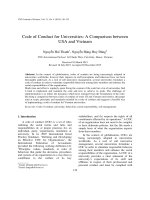DSpace at VNU: Specializations of Rees rings and integral closures
Bạn đang xem bản rút gọn của tài liệu. Xem và tải ngay bản đầy đủ của tài liệu tại đây (3.12 MB, 8 trang )
VN U . J O U R N A L O F S C I E N C E , M athem atics - Physics. T .x x , N q 4 - 2004
S P E C IA L IZ A T IO N S
AND
OF REES
IN T E G R A L
R IN G S
CLOSURES
D a m Van N hi
Pedagogical University Ha Noi, Vietnam
P h u n g T h i Y en
The .Upper Secondary School Dong Anil, Hrt Noi, Vietnam
A b s t r a c t . The paper presents the specializations of Rees rings, associated graded rings
and of integral closure of ideals. T h e preservation of some invariants of lings by special
izations will also be concerned.
In tro d u c tio n
Let k be an infinite field of arbitrary characteristic. Denote by K ail extension field
of k. Let u = ( u i , . . . , U t n ) be a family of indet.ennina.tes and o = ( a i , ... , O',,,.) a family
of elements of K . We denote the polynomial rings in n variables £ 1 , . . . , x n over k(u) and
k(ot) by R = k(u)[x] and by R Q = k(ct)[x], respectively.
The first step toward ail algebraic theory of specialization was the introduction of
the specialization of ail ideal by w . Krull [2]. Let I be an ideal of R. The specialization
of 1 with respect to the substitution u — > a € k m is the ideal
If* = { / ( a ,x ) | /(w,x) G /nfe[u,:r]} c fc[x].
Following [2] the specialization of / wit h respect to the substitution u — > a G A
defined as the ideal I Q of 7?a generated by elements of the set
is
{/(a ,a ;)|/K .x )G /n A ;[^ x ]}.
A. Seidenberg [7] used specializations of ideals to prove th at hyperplane sections of nor
mal varieties are normal again under certain conditions. Using specializations of finitely
generated free modules and of homomorphisms between them, we defined in [4] the special
ization of a finitely generated module, and we showed th at basic properties and operations
on m od u les are preserved by s p ecia liza tio n s. Ill [3] we followed th e sam e approach to in
troduce and to s t u d y s p e c ia liz a tio n s o f finitely gen erated m od u les over a local lin g [4] and
of graded modules over graded ring [5]. We will give the definitions of specializations of
Rees rings and associated graded rings, which are not finitely generated as /?-mođules and
we want also to study specializations of integral closures of ideals.
In this paper, wc shall say th a t a property holds for almost all a if it holds for all
points of a. Zariski-open non-empty subset of K ni. For convenience wo shall often omit the
phrase "tor almost all a ” ill the proofs of the results .
1T h e a u th ors are p a r tia lly su p p o rted by th e N ation al B asic Research Program
T y p eset by ^Ạa/Í-5-T^X
25
26
D a m Van N h i , P h u n g Thi Yen
1. S o m e r e s u l t s a b o u t s p e c i a li z a t io n o f g r a d e d m o d u l e s
Let k be an infinite field of arbitrary characteristic. Denote by K an extension field
of k. Let u = ( u .. , Urn) be a family of indeterminates and a = ( « ! ,. .. ,Qm) a family
of elements of K . Let m and ma be the maximal graded ideals of R and i?Q, respectively.
The specialization of ideals can be generalized to modules. First, each element
a(u, x) of R can be written in the form
p( u, x)
a( u, x) = —y "
q{u)
with p( u, x) G k[u,x] and q(u) £ k[u] \ {0}. For any a such th a t q(a) Ỷ 0 we define
p(a,x)
a{a, x) = ..> 7
■
q(a)
Let F be a free 7?-nio(lulo of finite rank. The specialization Fa of F is a free
7?tt-modulo of the same rank. Let Ộ : F — > G be a homomorphism of free 7?-modules.
We can represent Ộ by a matrix A = (di j (u, x)) with respect to fixed bases of F and
G. Set Aa = (.atj ( a , x )). Then A a is well-defined for almost all a. The specialization
ộct • Fa — > Ga of Ộ is given by the matrix A a provided th a t A q is well-defined. We note
that the definition of (f)a depends on the chosen bases of Fa arid G a .
D e fin itio n . [3] Let L be ail i?-mocỉule. Lot Fi - A F() — > L — > 0 be a finite free
presentation of L. Let 0 Q : (F i) a — > (F0)a be a specialization of Ộ. We call L a :=
Coker 0 a a specialization of L (with respect to ợí>).
If w e ch oo se a different finite free p resen ta tion
— > Fq — > L — > 0 we m ay get a
different specialization L'a of L, but L a arid L[y are canonically isomorphic [4, Proposition
2.2]. Hence L a is Iliiicjilcly deterniinecl up to isomorphisms. T he following lemmas show
that the operations and the dimension of modules are preserved by specialization.
L e m m a 1 . 1 . [3, Proposition 3.2 and 3.6] Let L be 3 finitely generated R-inocIule ãiìd
M , N submodules o f L, and Ỉ an ideal of /?. Then, for almost all O',
(i) ( L / M ) a = L a / M a ,
(ii) ( M n N ) a = M n n Na,
(iii) (M 4- N)a — Ma -f Na,
(iv) {IL)a = I a L a .
Let L be a finitely generated R -module. The dimension and depth of L are denoted
by (lim L and depth L, respectively.
L e m m a 1 . 2 . [3] Let L be a finitely generated R-nioclule. T h e n , for almost a 11 a, we have
(i) A n n L a = (Ann L)a ,
(ii) dim L a = dim L,
(iii) depth
= depth L.
We recall now some facts from [5] which we shall need later. First we note that R is
naturally graded. For a graded /?-inođule L, we denote by Lị the homogeneous component.
S p e c ia liza tio n s o f R e e s r in g s a n d in te g ra l clo su res
27
of L of degree t. For an integer h we let L(h) be the same module as L with grading shifted
by //., that is, we set L(1i)t = L/H-*.
Let F = © s=1 R ( —hj) be a free graded i?-rnodule. We make the specialization Fn
of F a free graded 7?a -moclule by setting Fa —
= i R o t(-h j). Let
s1
50
j=l
j=1
be a graded homomorphism of degree 0 given by a homogeneous m atrix A = (dij(u,x)).
Since
d e g (a ii(u ,x )) + hoi = . . . = deg (a iSo(u,x)) + h 0so = h u ,
A a = (a,; (a, j ) ) is a homogeneous m atrix with
<leg(«u(r>, x)) + hoi = . . . = deg (aiso( a, x) ) + hQso = h UTherefore, the homomorphism
ộct :
R a (-h lj)
j=1
»
R a ( —hoj)
j=1
given by the matrix i4a is a graded homomorphism of degree 0.
L e m m a 1.3. [5, Lemma 2.3] Let L be a finitely generated graded R-niodule. Then La
is a graded R a-inoduie for almost all a.
Let F .
0 — ■» Ft
Fg-I — ■ > • • • — > Fi
F() — > L — > 0 be a minimal graded free resolution of L, where each free module Fi may be written in the form
(Ị) R{ —j)- jlJ, and all graded homomorphisms have degree 0. The integers Pi j Ỷ 0 axe
called th e graded B e t t i n u m b e r s o f L. T h e follow ing lem m a sh ow s th a t th e graded B etti
numbers are preserved by specializations.
L e m m a 1.4. [5, Theorem 3.1] Let F # be a minimal graded free resolution of L. Then the
complex
( F .) „ : 0 — > (F ,)„
— > --------------------------------> (F ,)« (Fo)« — >— 0
is a minimal graded free resolution o f L a with the same graded B etti numbers for almost
ni l a .
2. S p e c ia liz a tio n o f R e e s r i n g s a n d a s s o c i a t e d g r a d e d rin g s
Let 1/ 1 , . . . , Vs be a sequence of distinct indeterminat.es. The polynomial ring of
2/1 , ■, i/s with coefficients in 7? is denoted by i?[y]. Let L be a finitely generated i?-module.
Then besides considering the polynomial ring R{y\ we may also consider polynomials ill
Ỉ/1 ? • • • iVs with coefficients belong to L. The set L[y} of all this polynomials has a natural
structure as a module over R[y]. It is easily seen th at L[y] = L
L[y}. Here we have
28
D a m V a n N h i , P h u n g T h i Y en
L em m a 2.1. Lot L be a. finitely generated R-module. Then L[y}rt = L a [y} for almost nil
at.
Proof. Let W'
and R n
>
R '1 — » L — * 0 be a finite free presentation of L. SÌ11C(' R — > /?[/;]
are flat, we call deduce thirlt the sequences
0 and
L [y]
0
V ^l
are finite free presentations of L[y] and L n , respectively. From the definition of specialization L[y]ữì the following sequence is exact
I f \ y \ „ — * L[y]a — t 0 .
«"[!/]„
Because i i'l [y]Q = /?':[/;] and (yj® 1 )Q = ự>0 ® 1 , therefore L[y]Q=* L a [y],
Let / be an ideal of R. Denote the ring R / I by D. Let a be an ideal of B. We
D[at] = 0
set
aJ tJ c B[t],
j> 0
G(a, D) = ( Ị) a j tj /aj+1tj+1.
j> 0
Both. #[ai] and G(n, z?) are graded rings. D[at] is railed tile Rees ring and G(a D)
th e asso ci ate d gr a de d rin g of 13 w ith respect to n. If n is g e n e r a te d by III
then D[at] = D[ a i t , . .. , n st}. Note that D„ = /?„//,,.
Su])Ị)()S(' that ,7 is an ideal of R such that, I c J and a = J / I . T hen a
a specialization of a by Lemma 1 . 1 .
(1
E R /Ỉ
= J /I
is
Definition Let a be an ideal of D. We call B a [aa t] and G( aa , B 0 ) as the specializations of
z?[af] and G ( a , D ) i respectively.
P r o p o s i t i o n 2.2. L et a be a proper ideal o f D. T h en, for almost O', we have
0)
d i i n z* « [ o „ f ] G ( c i q , Du ) = d h n D[ot] G ( a , B),
(ii) dim B a [a(yt] = dim z?[af].
Proof, (i) There is dim
= dim £ by Lemma 1 .2 . Since dim B(>[0((t] G (a ,,,B a ) =
dim Dn and cliinc[at] G(d, D) = dim D from [9, Chapter IV Proposition 1 .9], it follows
that diinBafnot] G (a„, Da ) = đim B[aí] G(a, D).
(ii) Consider the B-algebm homomorphism Ộ : B[ y u . .. — ■> D\at], y, I— > a,t. Denote
by J the icloal of, y s , t ] generated by the polynomials tjj — (lit i — 1 ... s. By
[10 , Proposition 7.2.1] , there is
B[at) = D[yu
, y s] / J n D\ifU . . . , ys\.
Using Lemma 2 . 1 , vve can specialize Dịat}. similarly, we have
B[at}u =
(/% !,...
, f j s } / J nn { t j i , . . .
, y.,])a =
Da [tju . . .
, y.s ] / J , . n / ^ L v i ............... / / , ] =
Since dim B\at]a = (lini/?[a/j by Lc-nnna 2.1. there is dim B a [fl(lt] = dimi?[ai].
B n [a„t}.
S p e c ia liz a tio n s o f R e e s r in g s a n d in te g ra l c lo s u re s
29
P r o p o s it i o n 2.3. Let a be a proper ideal o f B. T h e n , for almost a , we have
(i) depthBn[0ot| G (a„, D„) = d e p th B|ot] G(a, 5 ) ,
(ii) depth B a [aa t] = d e pth B[ai].
Proof. The proof is immediate from Lemma 1.2 and [4, Theorem 3.1].
Recall th at a ring A is à Cohen-Macaulay ring, if dim A — depth A. The following
corollary shows th at the Cohen-Macaulay property of a Rees ring or an associated graded
ring is preserved by specializations.
C o ro lla ry 2.4. IĩBịat}, (resp.G(a, B) ), is Cohen-Macaulay, then £?a [aa £], (resp.G (aa , B a ),
is again Cohen-Macaulay.
Proof. By an easy com putation, the proof follows from Propositions 2.2 and 2.3.
Now we will show th a t the multiplicity of associated graded ring is preserved by
specialization.
P r o p o s it i o n 2.5. Let q =
Then, for almost all a , wc have
, yd)B be a parameter ideal o f B , where dim D = d.
e(qa ; G (aa , B a )) = e(q; G(a, B)),
where e(qa ]G(act, B a )) and e(q; G( a , B) ) are the multiplicities o f G( a fỵ, B (i) and G( d, B)
respectively.
Proof. By Lemma, 1.2, d i m B a = d. By [7, Lemma 1.5] the ideal
^\ol( ( y 1 ) Ot Ì • • • Ĩ ( y d ) Oc)
is again a param eter ideal on B a and e(qa \ B (yi) = e(q;Z?) by [6 , Theorem 1 .6]. Because
e(qa ; ơ ( a a , -Gfv)) = e(qrv; jQa ) and e(q; G(a, 73)) = e(q; -D), then the proof is complete-.
3.
N o e t h e r n o r m a l i z a t i o n s a n d i n t e g r a l c lo s u r e s b y s p e c i a l i z a t i o n s
Consider the stand ard graded ring R = k[x 1 , . . . , x n] with (leg(x.j) = 1 for all
j = 1 , . . . , n. Throughout this section, I will denote a homogeneous ideal of R and the
residue class ring R / I will again denote by B. P u t climZ? = d. Let us recall the notion of
Noether normalization of a ring. Suppose th at / i , . . . , fd are polynomials of R. The sub
ring fc('u)[/i, • • • , /V/] is called a Noether normalization of D if / i , . . . , fci are algebraically
independent over k and D is a finitely generated fc (u )[/i,... , /d]-rnodule. The following
proposition shells show th a t a specialization of a Noether normalization of a ring is again
a Noether normalization.
P r o p o s i t i o n 3.1. A ssum e that d i m B = d and / i , . . . , fd £ /? are homogeneous polyno
mials o f positive degrees. I f the subring k( u) [ f 1 ,. . . , fd] is a Noether normalization o f D ,
then the snbring k ( a ) [ ( f i ) a , . . . , (/r/)a] is also a Noether normalization o f Bo,.
Proof. We have dim I?a = dimJ3 = d by Lemma 1.2. By definition of specialization,
( / l ) Q) ■• • , ( / d ) a are h o m o g e n e o u s p o ly n o m ia ls w ith c l e g ( / j ) Q = d e g / j for all J - I , . .. , d.
D a m V an N h i , P h u n g T h i Yen
30
By virtue of Lemma 1.1 one can deduce ( B / ( / i , . . . ,/d ) ) a = 5 q / ( ( / i ) q , . . . , (/d)a). From
[10, Proposition 2.3.1], it is well known th a t the subring k(u) [ / i , . .. ,fd] is a Noether
normalization of D if and only if climfc(u) B / ( / i , . . . , /d) < oo. Assume th a t the subring
fc(ii)[/i,... , /ci] is a.Noether normalization of s. T hen d i m B / ( / i , . . . , fd) = 0. By Lemma
1.2, d i m ( B / ( / i , . . . , f d) ) Q = 0. Hence the subring f c ( a ) [ (/i) a ,. . . , (fd)a] is also a Noether
normalization of Da .
The ring D is said to satisfy Serre’s condition ( Sr ) if depth Bp > min{r, dim Bp}
for all p £ Spec(-R). W ith out loss of generality we can assume th a t A = k(u)[x 1 , . . . ,Xd]
is a Noether normalization of B. In this case B is a finitely generated graded A-module.
Using the above proposition we are now in a position to prove the following result, see [6,
Lemma 4.3].
C o ro lla ry 3.2. I f B satifies Serre’s condition (Sr), so is Da for almost all a.
Proof. We consider D as a. finitely generated graded A-module. Suppose that
F . : 0 — > A dt ^
A d' - ' — > -------- > A di ^
A d° — > D — > 0
is a minimal graded free resolution of D. Denote by I j ( B ) the ideal I,
— rank(/?j.
By [10 , Proposition 7.1.3], we know th a t D satifies (Sr) if and only if ht I j ( B) > j + r , j > 0.
By Proposition 3.1, A a = Ả;(a)[xi,. . . ,Xd] is a Noether normalization of Bex and
F . q : 0 — A ị'
A ị ' - 1 — > -------- ■> A ị l
A ị° — * Da — ►0
is a minimal graded free resolution of Da by Lemma 1.4. Since ra n k (ipj)ct — ra n k ipj and
lit I j ( B„) = ht I j ( B) f()r all j > 0 by Lemma. 1.2, therefore B cỵ satifies Serre’s condition
(Sr) by [10. Proposition 7.1.3].
The proplern of concern is now the preservation of the reduction number of D by
specializations. First, let us recall the definition of reduction num ber of a graded algebra.
Assume that B = ©t>o-ơf is a finitely generated, positively graded algebra over a field
D q — k 1 and z 1 , . . . , Zd G k \ [ D\ ] su ch th a t A = k \ [ z \ , . . . , Zd] is a N ot her n orm alization of
B. Let
. . . , v s be a minimal set of homogeneous generators of D as an A-module
s
D =
A v j , deg Vj = m j .
j= i
The reduction n u m b e r t a ( B ) o f D w ith resp ec to
is t h e su p r em u in o f all rrij.
P r o p o s it i o n 3.3. Let A be a Noether normalization o f B . Then
almost all a.
v a {B)
= VAfX(Ba) for
Proof. As above, without loss of generality we can assume th a t A — /c(u)[a:i,. . . , X(i\ is a
Noether normalization of B. Let V i , . .. , v s be a minimal set of homogeneous generators
of B as ail Ẩ-rnodule
s
B =
A v j , d e g Vj = rrij.
3=1
S p e c ia liz a tio n s o f R e e s r in g s a n d in te g ra l c lo s u re s
31
We have dim B a = d by Lemma. 1.2. T hen A a = k ( a ) [ x i , . \ . , x d] is a Noether normaliza
tion of Dry by Proposition 3.1 and Dn = Ỵ^S
j =i.A a(vj)a, deg(Vj)a = degVj by definition
of specialization. Hence TAa {B,y) = sup{deg(uj)Q} = sup{degVj} =
To study the specialization of integral closures of ideals we will recall the notion of
reduction of ail ideal, an object first isolated by N orthcott and Rees, see [1]. Let Q and b
he ideals of D. a is said to be a reduction of b if a c b and abr = br+1 for some nonnegative
integer r and th e least in teg er V w ith th is p rop erty is called th e r e d u c tio n num ber of b
with respect to a. This number is denoted by r a(b), and it is the largest non-vanishing
degree of b. An element 2 e B is integral over a if there is ail equation
z'n + a i z ' n~ l + ■• • + a , „ = 0, a , e a*.
Denote the set of all elements of D, which are integral over a, by n. ã is called the integral
closure of ideal a. Note th a t z £ 13 is integral over a if and only if z t € B[t] is integral
over B[at}. The set of all ideals of D which have n as a reduction has a unique maximal
member. T hat is Õ by [1, Corollary 18.1.6]. An ideal a is said to be integrally closed if
a — Õ. To study specializations of integral closures we need the following
L e m m a 3.4. Let a and (.1 be ideals u ỉ B.
(i) I f a c li, then n c b.
(ii) If a is a reduction of b , then b c Õ.
(iii) I f a is a reduction o f b, then ã = b.
Proof, (i) Assume th at a c b. Suppose th at 2 G ã. There is an equation
z'n + d \z'n
^ + ■ ■■ + ( l/n — 0 , (lị E Cl .
Since a' c IV', therefore 2 G b. Hence ã c b.
(ii) Assume that a is a reduction of b, then each element of b is integral over a by [1 ,
Proposition 18.1.5]. T hus b c a.
(iii) Assume that, n is a reduction of b. T hen a c b. Thus ã c b by (i). Because 0 is a
reduction of [i, therefore b c ã by (ii). Thus b c (ã). We need prove (ã) = ã. Since a is a
reduction of Õ and a is a reduction of (a) by [1 . Corollary 18.1.6], a is a reduction of (a).
It implies n = (ã) from the maximality of integral closure of a.
L e m m a 3.5. Let a be an ideal o f D. Then (a)a c aQ and (a)„ = a,, for almost nil a.
Proof. Note th a t if b is an ideal of D and a is a reduction of b, then there is an positive
integer r such th at all'- = IV+1. Hence a« c bQ and a„b';, = b ra+1 by Lemma. 1.1 (iv). Also,
a,, is a reduction of bu . Since a is a reduction of a, therefore aQ is a reduction of (o)o by
above note. Hence (0)o c 0^ and
= (ã)o follows from Lemma. 3.4 (iii).
T h e o r e m 3 . 6 . Let a be an ideal o f B. The integral closure o f the B ees ring Z3[a„/] is the
integral closure o f a specialization o f the integral closure o f the Rees ring D[at],
Proof. We know th at the inegral closure of D[at] is the graded subring T =
above definition, the specialization of T is the graded subring T a — © j> o(& )atJ
■By
the
D a m V a n N h i , P h u n g T h i Y en
3.
iiegalc.osure of T a is © j>o(aJ )QíJ . Because (aJ)a = nJ Q by Lemma 3.5 and a and j
„ y >econmmtc, i.e. (a J)q = ( aa )j = aJc , therefore ® j > o a 3a P is t h e integral closure o f a,
sjcili-tf'ion ®j>o(aj )a tJ for almost all a.
Fopiition 3.7. L e t q be a paramer ideal o f D. Then e(q^; D a ) = e(q: B) for almost, all
1)0 ] K well-known that e(q 77: B a ) = e(qa ] B a ) and e(q; D ) = e(q: B ) by [7], The proof
icjuidiite from the equation e(qa, B a ) = e(q; B) by [6. Theorem 1.6].
p.fteices
1 A- P. Brodm ann and R. Y. Sharp, Local Cohomology: an algebraic introduction
utk geometric applications, Cambridge University Press, 1998.
2 V. Krull, Pa.ra.meterspezialisierung in Polynomringen, Arch. Math., 1(1948), 56-64.
3 EV. Nhi and N .v . TVung, Specialization of modules, Comm. Algebra, 27(1999)
2*59-2978.
4 E.V Nhi and N .v . Trung, Specialization of modules over local ring, ./. Pure Appl.
Agebra, 152(2000), 275-288.
5 E V. Nhi. Specialization of graded modules, Proc. Edinburgh Math. Soc. 45(2002)
41-506.
OCV. Nhi, Preservation of some invariants of modules by specialization. ,/. of Sc.iex'f, VNU t. XVIIL Math.-Phys. 1(2002), 47-54.
7 DC. N orthcott and D.Rees, Reductions of ideals in local rings, Math. Plot:. Can lb
Pil Soc., 50(1954), 145-158.
8A Seidenberg, The hyperplane sections of normal varieties, Trans. Arner. Math.
Sc, 69(1950), 375-386.
y j Sriickrad and w . Vogel, Buchsbaum rings and applications, Springer Berlin.
ISC.
()W /. Vasconcelos, Computational methods in commutative algebra and algcbraic
gorn.etry, Springer-Verlag Berlin Heidelberg Now York, 1998.

